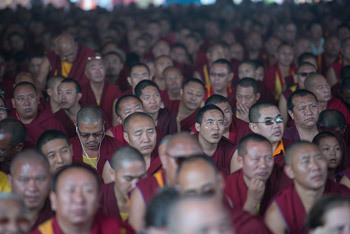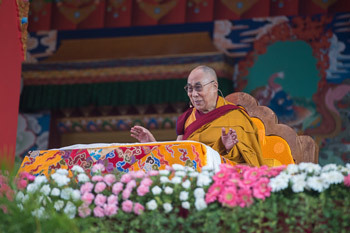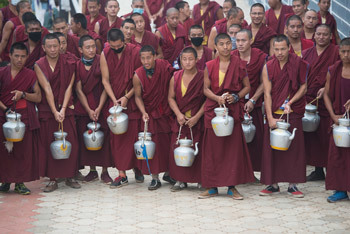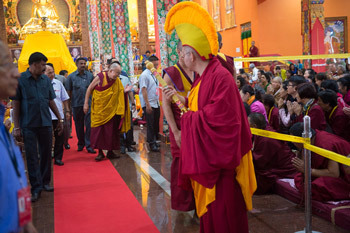Tashi Lhunpo, Bylakuppe, Karnataka, India, 21 December 2015 - The Karnataka countryside around Tashi Lhunpo was shrouded in mist early this morning as His Holiness the Dalai Lama continued his teaching of the Stages of the Path to Enlightenment.
“All sentient beings on this earth want happiness and don’t want suffering. It’s quite evident. While wishing to avoid pain, they seek pleasure from sensory experience. We human beings have evolved particularly sophisticated brains that enable us to use our intelligence. For us, mental experience is stronger and more effective than sensory experience. About 200 years ago scientific developments led to more rapid material development. Because the consequent sensory pleasure seems more immediate it gives a measure of satisfaction.
“One consequence is that modern education now tends to focus on material development to the neglect of inner values. Greater material development has not been matched by greater inner peace. If your mind is not at ease, it disturbs your physical well-being too. Cultivating inner values is the source of peace of mind, but no single religion will satisfy this need for everyone and an estimated one billion human beings have no interest in religion. The solution therefore is to cultivate a sense of secular ethics. This is an approach pursued for centuries in India, where the hedonist and nihilist sect the Charvakas attracted intense philosophical opposition and yet their teachers were referred to as Rishi or Sage.
“I believe that if the Buddha appeared among us today, he would teach secular ethics. What was unique about his teaching was his explanation of selflessness, and yet there were occasions when what he taught seems to have implied the existence of such a self. This was because that is what helped the particular people listening to him. Therefore, in the present context, we could imagine he would teach secular ethics because that is what we need today. This is consistent with the Buddha’s teachings being meant for overcoming suffering and achieving happiness.”

|
Some of the thousands of monks and nuns attending His Holiness the Dalai Lama's Jangchub Lam Rim teachings at Tashi Lhunpo Monastery in Bylakuppe, Karnataka, India on December 21, 2015. Photo/Tenzin Choejor/OHHDL
|
Resuming his reading of Zhamar Pandita’s ‘Treatise on the Stages of the Path to Enlightenment’, His Holiness said the goal is to lead a meaningful life. Love and compassion bring benefit to self and others, malice only brings harm. Creating enemies does not lead to happiness.
He told a story from his childhood in Lhasa. At the Norbulingka there were a number of caged birds. A parrot among them was prone to peck the fingers of those who came near, except for the monk who taught His Holiness calligraphy. He would bring seeds and nuts to feed it and it grew so fond of him that it would become excited just to hear his approaching footsteps. His Holiness said he was jealous. He wanted to the parrot to like him too and one day, when it wouldn’t respond, he crossly poked it with stick. That was the end of any possibility of their becoming friends.
While reading advice about taking refuge in the Three Jewels in ‘Liberation in the Palm of Your Hand’ His Holiness was reminded of an episode at a World Parliament of Religions meeting in Australia. A couple of Burmese monks expressed a wish to meet him. They acknowledged following the same teacher, the Buddha, but said there remained differences between them. His Holiness agreed but disarmed them when he said, “But the practice of Dharma needs to be based on Vinaya, where you follow the Theravada tradition, we follow the Mulasarvastivadins,” because they seemed not to know that Tibetan Buddhists observe Vinaya.
After stern words in ‘Liberation in the Palm of Your Hand’ about Bön, His Holiness clarified that Bön is the indigenous religion of Tibet that existed there before the arrival of Buddhism. Nowadays, he said, Bönpo monks study and debate much as Buddhist monks do. The tradition is no longer as it was in pre-Buddhist days.

|
His Holiness the Dalai Lama during the second day of the Jangchub Lam Rim teaching at Tashi Lhunpo Monastery in Bylakuppe, Karnataka, India on December 21, 2015. Photo/Tenzin Choejor/OHHDL
|
After lunch, he said: “What distinguishes Buddhism from other religious traditions is the teaching of dependent arising. As Tsongkhapa’s ‘Praise of Dependent Arising’ makes clear, it’s a doctrine worthy of respect.”
With regard to the line “Lead others to this refuge (in the Buddha, Dharma and Sangha)” and implicit criticism of other religions in the text, His Holiness said it was important not to offend, but to maintain inter-religious harmony. The main advice of taking refuge in the Three Jewels, which is common with other traditions, is to help others.
His Holiness was also prompted to speak about the need for more women leaders.
“Originally human communities had little leadership, but with the development of agriculture and possession of property came a need to protect it. The crucial factor was physical strength so men became leaders. Since then education has allowed for more equality. However, the social convention that men lead has spilled over into religious tradition too. Although the Buddha ordained men and women as bhikshus and bhikshunis respectively, the bhikshus asserted precedence and sat in front.
“It’s not that we need women leaders just so there is equality, we need women leaders for the qualities they bring to the role. There is scientific evidence that women are more sensitive to the suffering of others. They have greater facility for empathy. War heroes and butchers are mostly men, whereas carers, like nurses, are mostly women.
“I’m not joking when I reply positively to questions about whether a future Dalai Lama could be a woman. It’s quite possible. There are precedents for high female reincarnations in Tibet already. The Chinese have been critical of my remarks about my potential reincarnation. In the past, it’s true the Chinese Emperor exercised some influence over the recognition of some Lamas’ reincarnations, but in those days the Emperors were Buddhist.

|
Monks waiting to begin serving tea during the afternoon session of the second day of His Holiness the Dalai Lama's Jangchub Lam Rim teaching at Tashi Lhunpo Monastery in Bylakuppe, Karnataka, India on December 21, 2015.
Photo/Tenzin Choejor/OHHDL
|
“I’ve suggested that if the Chinese leadership today wants to have something to do with the Dalai Lama’s reincarnation, they should first recognise the reincarnations of Mao Zedong and Deng Xiaoping.”
Coming back to the Lam Rim text and its explanation of karma, His Holiness remarked:
“What’s important is to understand what is to be adopted and what abandoned in relation to the law of causality.”
His Holiness stopped reading a little early and the session concluded, as it does daily, with a rousing recitation of the Lam Rim Dedication Prayer, whose strident tones rise steadily to a climax and then fall away to quiet
















